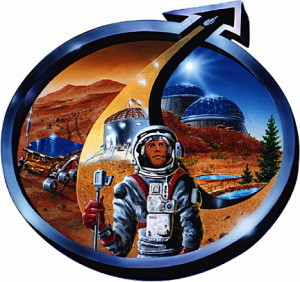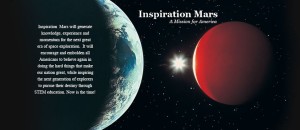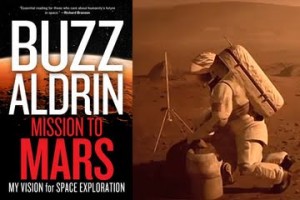By: Nicole Willett and The Mars Society
 Annual conventions have become a staple of The Mars Society. Many leading scientists, researchers, and entrepreneurs hold plenary talks and participate in panel discussions regarding many aspects of the human exploration and settlement of the Red Planet. The 17th Annual Mars Society Convention will be held from August 7-10, 2014 in the Houston area in League City, Texas (near NASA’s Johnson Space Center). The convention will be at the South Shore Harbour Resort.
Annual conventions have become a staple of The Mars Society. Many leading scientists, researchers, and entrepreneurs hold plenary talks and participate in panel discussions regarding many aspects of the human exploration and settlement of the Red Planet. The 17th Annual Mars Society Convention will be held from August 7-10, 2014 in the Houston area in League City, Texas (near NASA’s Johnson Space Center). The convention will be at the South Shore Harbour Resort.
The Mars Society invites presentations for the 17th Annual International Mars Society Convention. Subjects for discussion can involve all matters associated with the exploration and settlement of the planet Mars, including science, technology, engineering, politics, economics, public policy, etc.
If you would like to submit an abstract to be considered for a presentation at the convention you may email your submission here. Email is preferred, however you may mail your submission to The Mars Society, 11111 West 8th Avenue, Unit A, Lakewood, CO 80215 . The submissions are to be no more than 300 words and must be submitted by June 30th. A few of the proposed conference sessions are:
- The search for life on Mars
- Latest findings from Mars spacecraft
- Why Mars?
- Plans for 2014 Mars missions and beyond
- Curiosity rover – research & accomplishments
- Concepts for future robotic Mars missions
- For further details and a full list of conference sessions, click here.
The convention is open to the general public and everyone is encouraged to attend. The four-day event will bring together key experts, scientists, policymakers and journalists to discuss the latest news on Mars exploration and efforts to promote a human mission to the Red Planet in the coming years. To register for the event click here.
 If you would like to view some of the presentations from previous years, please visit the Mars Society Channel on Youtube. You will see previous Mars Pioneer Award winners and their keynote address. The recipient for the 2012 award was Elon Musk, founder of SpaceX and Tesla motors. Musk passionately discussed the importance of a humans to Mars mission and how and why it should be done. The 2013 recipient was Dr. Steve Squyres, the Principal Investigator for the Mars Exploration Rover Spirit and Opportunity. Dr. Squyres gave a wonderful update on the Opportunity Rover and an entertaining history of the MER program.
If you would like to view some of the presentations from previous years, please visit the Mars Society Channel on Youtube. You will see previous Mars Pioneer Award winners and their keynote address. The recipient for the 2012 award was Elon Musk, founder of SpaceX and Tesla motors. Musk passionately discussed the importance of a humans to Mars mission and how and why it should be done. The 2013 recipient was Dr. Steve Squyres, the Principal Investigator for the Mars Exploration Rover Spirit and Opportunity. Dr. Squyres gave a wonderful update on the Opportunity Rover and an entertaining history of the MER program.
 At the 16th Annual Mars Society Convention, Dennis Tito, founder of Inspiration Mars, announced an international engineering competition for student teams to propose design concepts for the architecture of the Inspiration Mars mission. The contest is open to university engineering student teams from anywhere in the world. Inspiration Mars Executive Director Dennis Tito and Program Manager Taber MacCallum were present for the announcement. “Inspiration Mars is looking for the most creative ideas from engineers all over the world,” said Tito. “Furthermore, we want to engage the explorers of tomorrow with a real and exciting mission, and demonstrate what a powerful force space exploration can be in inspiring young people to develop their talent. This contest will accomplish both of those objectives.” The requirement is to design a two-person Mars flyby mission for 2018 as cheaply, safely and simply as possible. All other design variables are open. The Mars Society’s Inspiration Mars International Student Design Competition has drawn a massive worldwide response. As of the January 31, 2014 deadline, letters of intent to compete have been received from 38 teams representing 56 universities in 15 countries. Nations represented include the United States, Canada, Russia, the Netherlands, Germany, Austria, Italy, the United Kingdom, Portugal, Poland, Mauritius, India, Bangladesh, Japan and Colombia. A sampling of some of the institutions signed up to participate include: John Hopkins University, St. Petersburg State Polytechnical University, Ohio State University, Warsaw University of Technology, University of Notre Dame, Indira Gandhi National Open University, York University, International Space University, Purdue University, Islamic University of Technology, University of Stuttgart, Keio University, and University of Glasgow.
At the 16th Annual Mars Society Convention, Dennis Tito, founder of Inspiration Mars, announced an international engineering competition for student teams to propose design concepts for the architecture of the Inspiration Mars mission. The contest is open to university engineering student teams from anywhere in the world. Inspiration Mars Executive Director Dennis Tito and Program Manager Taber MacCallum were present for the announcement. “Inspiration Mars is looking for the most creative ideas from engineers all over the world,” said Tito. “Furthermore, we want to engage the explorers of tomorrow with a real and exciting mission, and demonstrate what a powerful force space exploration can be in inspiring young people to develop their talent. This contest will accomplish both of those objectives.” The requirement is to design a two-person Mars flyby mission for 2018 as cheaply, safely and simply as possible. All other design variables are open. The Mars Society’s Inspiration Mars International Student Design Competition has drawn a massive worldwide response. As of the January 31, 2014 deadline, letters of intent to compete have been received from 38 teams representing 56 universities in 15 countries. Nations represented include the United States, Canada, Russia, the Netherlands, Germany, Austria, Italy, the United Kingdom, Portugal, Poland, Mauritius, India, Bangladesh, Japan and Colombia. A sampling of some of the institutions signed up to participate include: John Hopkins University, St. Petersburg State Polytechnical University, Ohio State University, Warsaw University of Technology, University of Notre Dame, Indira Gandhi National Open University, York University, International Space University, Purdue University, Islamic University of Technology, University of Stuttgart, Keio University, and University of Glasgow.
 The University Rover Challenge (URC) is a robotic rover design competition that encourages college students to create rovers using guidelines set by The Mars Society. URC teams are currently working on their rovers. The seventh annual rendition of the international competition for college students is organized by The Mars Society and will be held May 30 – June 1, 2013 at the Mars Desert Research Station (MDRS) near Hanksville, Utah. This unique and renowned competition has hosted dozens of college teams since 2007 in a barren landscape that is an ideal analog of the planet Mars. The MDRS site is also home to human crews conducting mission simulations that test a broad range of Mars exploration topics. URC rovers are designed and built to one day assist astronauts on the Red Planet. The URC has a record 31 teams this year! Click here for more information on how you can join the URC.
The University Rover Challenge (URC) is a robotic rover design competition that encourages college students to create rovers using guidelines set by The Mars Society. URC teams are currently working on their rovers. The seventh annual rendition of the international competition for college students is organized by The Mars Society and will be held May 30 – June 1, 2013 at the Mars Desert Research Station (MDRS) near Hanksville, Utah. This unique and renowned competition has hosted dozens of college teams since 2007 in a barren landscape that is an ideal analog of the planet Mars. The MDRS site is also home to human crews conducting mission simulations that test a broad range of Mars exploration topics. URC rovers are designed and built to one day assist astronauts on the Red Planet. The URC has a record 31 teams this year! Click here for more information on how you can join the URC.
 The Youth Rover Challenge (YRC) is a multi-tier robotics education development program that is hosted, sponsored and operated by The Mars Society. The program commenced on August 6th, 2013 to commemorate the one year anniversary of the landing of NASA’s Curiosity Rover. YRC is a STEM related educational effort that is designed for schools and organizations with students or members in grades 5-12 to have the chance to build and compete at a global level with a LEGO Mindstorms NXT 2.0 based robotic rover and competition arena intended to simulate the surface of Mars. The YRC has 26 teams registered for this year’s competition. For more information visit the Youth Rover site or email Deputy Director Chuck McMurray.
The Youth Rover Challenge (YRC) is a multi-tier robotics education development program that is hosted, sponsored and operated by The Mars Society. The program commenced on August 6th, 2013 to commemorate the one year anniversary of the landing of NASA’s Curiosity Rover. YRC is a STEM related educational effort that is designed for schools and organizations with students or members in grades 5-12 to have the chance to build and compete at a global level with a LEGO Mindstorms NXT 2.0 based robotic rover and competition arena intended to simulate the surface of Mars. The YRC has 26 teams registered for this year’s competition. For more information visit the Youth Rover site or email Deputy Director Chuck McMurray.
The Education Forum continues its outreach efforts by hosting speaking engagements in person or via the web. If you would like to schedule an event for your class, troop, astronomy club, or other organization, please contact Education Director Nicole Willett. The talks range from 30 minutes to an hour. The purpose is to educate the public to our place in the universe and the importance of the human exploration and settlement of the planet Mars. To see a list of previous events and accompanying images please click here.
Join The Mars Society Today and Help Play a Role in
Humanity’s Next Step into the Solar System!
All Mars Society members receive:
+ An official membership card
+ Regular Mars Society email updates & announcements
+ The Mars Quarterly online magazine
+ An opportunity to participate in local Mars Society chapter events & activities
+ A special invitation & discount to the International Mars Society Convention
+ Special access to exclusive online chats, webinars & discussions with leading Mars experts
[Images: The Mars Society, Youtube, Inspiration Mars]









